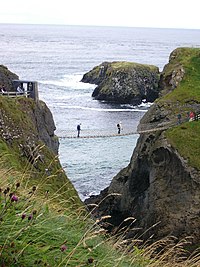Carrick-a-Rede Rope Bridge
| Carrick-a-Rede Rope Bridge | |
|---|---|
 |
|
| Locale | Ballintoy, County Antrim |
| Characteristics | |
| Design | simple suspension bridge |
| Material | rope |
| Total length | 20 metres (66 ft) |
| Height | 30 metres (98 ft) |
| No. of spans | 1 |
| Load limit | 8 pedestrians |
| History | |
| Constructed by | Heyn Construction |
| Opened | 2008 (current bridge) |
| Statistics | |
| Toll | £5.90 |
Carrick-a-Rede Rope Bridge (locally pronounced carrick-a-reedy) is a famous rope bridge near Ballintoy in County Antrim, Northern Ireland. The bridge links the mainland to the tiny island of Carrickarede (from Irish: Carraig a' Ráid, meaning "rock of the casting"). It spans 20 metres (66 ft) and is 30 metres (98 ft) above the rocks below. The bridge is mainly a tourist attraction and is owned and maintained by the National Trust. In 2009 it had 247,000 visitors. The bridge is open all year round (subject to weather) and people may cross it for a fee.
It is thought salmon fishermen have been building bridges to the island for over 350 years. It has taken many forms over the years. In the 1970s it had only one handrail and large gaps between the slats. A new bridge, tested up to ten tonnes, was built with the help of local climbers and abseilers in 2000. Another was built in 2004 and offered visitors and fishermen alike a much safer passage to the island. The current wire rope and Douglas fir bridge was made by Heyn Construction in Belfast and raised early in 2008 at a cost of over £16,000. There have been many instances where visitors, unable to face the walk back across the bridge, have had to be taken off the island by boat.
On 24 May 2017, a routine inspection revealed that the bridge's structural ropes had been damaged overnight in an act of vandalism. The National Trust announced that the bridge would be closed "for the forseeable future". However, on the following day it was announced that structural engineers had completed repairs, and that the bridge had been reopened.
It is no longer used by fishermen during the salmon season, which used to last from June until September, as there are now very few salmon left. In the 1960s, almost 300 fish were caught each day, but by 2002, only 300 were caught over the whole season. The salmon come through the area to spawn in the River Bann and the River Bush.
...
Wikipedia
